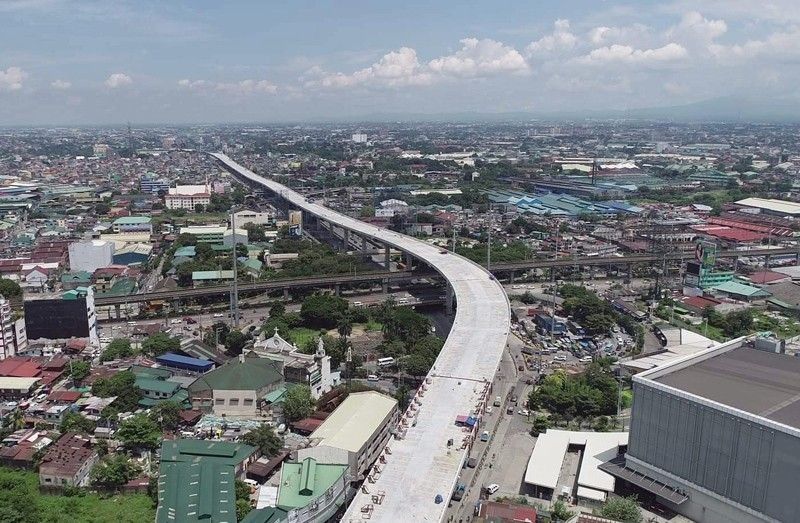Pandemic slows down momentum of flagship infrastructure projects

(First of two parts)
Motorists who happen to drive along the Skyway Stage 3 elevated highway during golden hour are sure to savor the breathtaking view – the round crimson sun slowly disappearing on the horizon with Metro Manila’s skyline backlighted by the setting sun.
It is majestic, almost magical and it surely adds to the pleasurable drive – albeit just a few minutes – when one traverses the Skyway, the newest road in the metropolis, which connects the North and South Luzon Expressways.
It’s no surprise that the rave over the Skyway continues, months since it first opened last year.
The Skyway Stage 3 elevated toll way, built and operated by San Miguel Corp.’s SMC Infrastructure, is no doubt a welcome development for Filipinos who have long been bearing the brunt of traffic in Metro Manila, which during the pre-COVID-19 days often delayed daily travel by one to two hours.
This is very much a welcome development especially for Filipino motorists.
Late to the party
But putting it in a bigger context, the reality is that the Philippines is very much late to the party. Its peers in the Southeast Asian region have more developed roads and infrastructure.
Just looking at road infrastructure in East Asia for instance, the Philippines lags behind Malaysia, China, Thailand and Indonesia in terms of quality of road infrastructure. It is only ahead of Cambodia, Vietnam, Laos and Mongolia, according to a World Bank 2018 Global Competitive Report.
The World Bank said access to road infrastructure is not enough to attain trade and transit development goals. The quality of the roads is equally important, it said.
The quality of road infrastructure is also an important factor in minimizing the transaction costs of travel and trade and improving the efficiency and resilience of road networks, it also said.
“Amongst emerging economies, Malaysia easily scores highest, although conditions are significantly better in West Malaysia than in East Malaysia. Nepal, on the other hand, is perceived to have the poorest road quality and is the only country to score less than 3. There is no data available on road quality for Pacific Island states,” the World Bank said.
Golden age of infrastructure
In Greek mythology, the golden age denotes a period of stability and prosperity. It is said that during this time, people did not have to work because the earth provided more than enough food.
In 2017, a year after he was voted into power, President Duterte vowed to usher in the golden age of infrastructure in the country.
With only a year to go before his term ends, The STAR examines where the government is now in its goal.
Two out of 75 projects
Initially, the government targeted 75 infrastructure projects, then expanded the list to 104 projects.
Thus far, only two projects have been completed -- the Angat Water Transmission Improvement Project and the Luzon Bypass Infrastructure Project.
The rest are either in pre-construction activities (34 projects), ongoing construction (44 projects), and “for government approval” stage (24 projects), according to the Philippine Institute for Development Studies (PIDS) in a 2020 study.
The good news is that the proposed infrastructure flagship projects are responsive to the government’s Philippine Development Plan targets in the area of information and communications technology, transport and mobility, water resources, and power and energy, PIDS said.
Wanting in social infrastructure
However, the ambitious Build Build Build program is wanting in the area of social infrastructure.
“These include school buildings and health facilities, and technology adoption and innovation,” PIDS said.
Build build build
Overall, the Duterte administration has laid out an ambitious program. But given the delays in the projects, the administration can only lay the groundwork for the program with some of the projects’ full completion to be seen only during the term of succeeding generations.
COVID-19
The global health pandemic that is COVID-19, which brought the world to its knees and the Philippine economy to its worst recession since World War II, only worsened the delays.
COVID-19 further delayed the implementation of the ambitious infrastructure blueprint although industry players said the government could have actually used the lockdowns--when there was no heavy traffic--to continue the construction of the projects.
Overall, the Duterte administration may not be able to end its term with a flagship infrastructure project; most of the big-ticket projects now including the Skyway Stage 3 were launched during the time of past administrations.
“What is the face of the Duterte administration’s Build Build Build program? None so far. There is no new airport, no major road it can actually call its own,” said a ranking official of a listed company which participates in the government’s Build Build Build program.
Department of Public Works and Highways
In terms of roads and bridges, however, Public Works Secretary Mark Villar said his department has actually completed three times more than what the previous administration has done.
Data supplied by his department showed that from 2016 to 2020, the DPWH has completed P2.5 trillion worth of projects versus the P820 million accomplished from 2011 to 2015.
In terms of projects, DPWH has built more than 5,000 bridges and 26,000 kilometers of roads
“I am quite satisfied with what we’ve done. If you look at the numbers, we’ve completed three times more than any other administration. I am quite happy about it,” Villar told The STAR.
Indeed, Build Build Build committee chairperson Anna Mae Lamentillo said the government has actually laid down a good program that would help the Philippines have much better infrastructure.
She said that goal is to build 25,343 kilometers of roads, 5,271 bridges and 9,797 flood mitigation structures.
Luzon spine network
The Luzon Spine Network is one of the major projects under the program.
A total of 906 kilometers of high standard highways and expressways in Luzon, which is about twice the 382-kilometer stretch of existing highways in the island, is envisioned to be part of the Luzon Spine Network.
Closer to home
Just like the Skyway, these new road networks will enable Filipinos to be closer to home and spend less time in traffic.
Once complete, those who live in the outskirts of Metro Manila will no longer have to brave an arduous commute to get to their place of work.
Lamentillo said many cities will be more connected.
(To be continued)
- Latest
- Trending
































